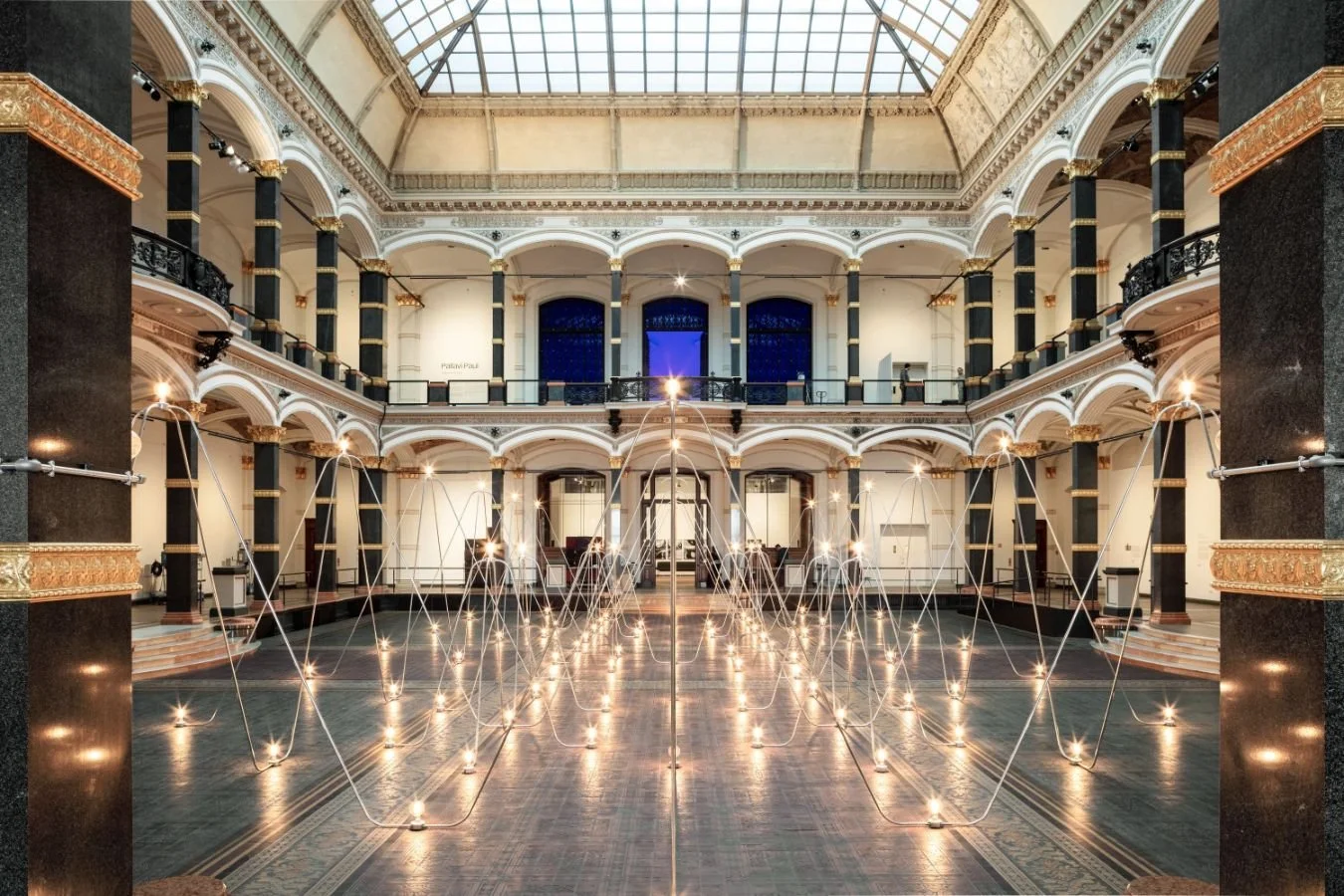Nancy Holt: Circles of Light @ Gropius Bau, Berlin
“Our life indoors is intertwined with life outside, with the whole planet actually.”
-Nancy Holt
Nancy Holt was an American artist, active since 1967 and until her death in 2014. Her art practice certainly does not fit into one movement, engaging with astronomy, physics, everyday life, and literature. Born in Massachusetts, Holt graduated in Biology from Tuft University. She later moved to New York City where she met her husband, artist Robert Smithson. Alongside the beginning of her art career Holt was in the position of assistant literary editor for Harper's Bazaar. Nancy Holt’s retrospective exhibition, Circles of Light is now on show at Gropius Bau, Berlin until July 2st 2024.
Nancy Holt, Electrical System, 1982. Gropius Bau Atrium, 2024. Photo Courtesy: Sprüth Magers, Luca Girardini.
Nancy Holt, Electrical System, 1982. Gropius Bau Atrium, 2024. Photo Courtesy: Maya Kil
Each element of Nancy Holt’s interests can be traced in the Gropius Bau exhibition. It is a retrospective, demonstrating the wideness of the artist’s practice. Pieces by an artist like Holt are difficult to curate within an institution since her practice includes many site-specific installations and generally draws on natural resources like sun and stars. Many works therefore are displayed as videos or photographs. For example, Sun Tunnels (1973-1976), giant concrete tubes located in Utah that capture the sunrise and sunset during the summer and winter solstice are exhibited as a video of the sun rising and setting within them. The setback of this compelling display is of course loss of the feeling of the scale of the installation, as well as its function as a mediator between nature and the viewer. The new media method of delivery nevertheless provides viewers with an opportunity to see time and space-specific installation at its brightest moment, during the solstice when the sun specifically goes through the end of the tube. This alone lets us see the installation that is miles away from us geographically.
Viewers at the Circles of Light exhibition. Photo Courtesy: Maya Kil
The exhibition takes up most of the Gropius Bau ground floor. The building is a beautiful site to visit on its own. Created by architects Martin Gropius and Heino Schmieden, the building served as an educational institution and museum since 1881. Considering Holt’s scientific approach to art, the venue engages in an interesting dialogue with her practice. The historical look of the building and the conceptualism of the artist’s work meet in guiding the spectator towards appreciating the aesthetics of the site and Holt’s installations, and at the same time engaging with the works critically.
In the exhibition, the works do not seem to be displayed in any particular order, or not an easy one to trace since the exhibition space is T-shaped. One of the rooms is dedicated to Concrete Poetry written in Harper's Bazaar era. Several rooms are fully dedicated to audience-engaging installations created in appreciation of everyday objects, activities, and phenomena. An installation honouring the role of light in everyday life, Electrical System (1982), is the one greeting the visitor in the Atrium. Another one, Electrical Lighting for the Reading Room (1985), takes place towards the end of the exhibition.
“The electrical systems light, the heating systems heat. The drainage systems drain, the ventilation systems circulate air […] the sculptures are exposed fragments of vast hidden systems, the are part of open-ended systems, part of the world.”
-Nancy Holt
Nancy Holt, Electrical Lighting for the Reading Room, 1985. Photo Courtesy: Maya Kil
Both installations can be perceived as functional sculptures. The function they serve is not only mechanical but also social. The spaces that installations provide gather visitors within them, the former in socialising with one another, the latter in reading and watching the books and videos provided in the space. Artworks like that have a high impact on the audience, they change the perception of art. Still as relevant as in the mid-eighties, Electrical System and Electrical Lighting for the Reading Room break the common paradigm of “art to be looked at” and make it an integral part of life and transform an art piece from an object into a space.
Nancy Holt, Locator with Mirror. 1972. Photo Courtesy: Maya Kil
A solo exhibition of Nancy Holt is a very slight but powerful reminder about women's position in contemporary art. Holt’s art draws on in-depth studies of astronomy and earth, the works include schematic drawings and calculations related to the phases of celestial bodies, all very cognitive, yet there is an important concept that her works relate to; cyclical time. The importance of this notion is even in the title of the exhibition: Circle of Light. While engaging with time cyclically is natural and astronomically logical, it is commonly considered a prerogative of women, while men more commonly have an illusion of linear time flow. Perhaps this is why Holt’s exhibition engages art appreciators so easily in science-related matters. Her art is very natural; not foreign to the mind. While the female role as a preserver is generally frowned upon, especially actively in female art at the end of the last era, Holt celebrates it by drawing our attention to what already exists and what always has in a very sophisticated yet minimal manner.
“I feel that the need to look at the sky—at the moon and the stars—is very basic, and it is inside all of us. So, when I say my work is an exteriorization of my own inner reality, I mean I am giving back to people through art what they already have in them.”
Nancy Holt inside of a Sun Tunnel. Photo Courtesy: Holt/Smithson Foundation.
Nancy Holt’s Circles of Light Exhibition is on until July 21st 2024. To find out more, visit Gropius Bau website.
Maya Kil
Interviews Co-Editor, MADE IN BED







